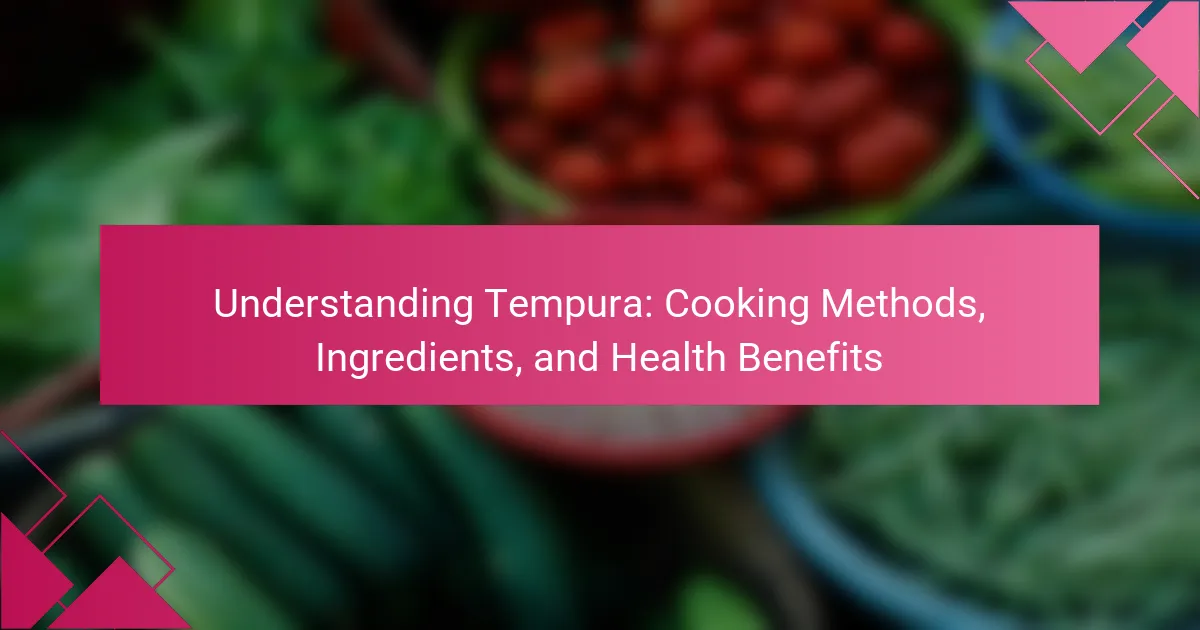
What is Tempura?
Tempura is a Japanese dish consisting of battered and deep-fried vegetables or seafood. The batter is typically made from cold water and flour, creating a light and crispy texture. Tempura originated in the 16th century, influenced by Portuguese cooking techniques. It is often served with a dipping sauce called tentsuyu, made from soy sauce, mirin, and dashi. Common ingredients for tempura include shrimp, sweet potatoes, and green beans. The dish is popular for its delicate flavor and appealing presentation. Tempura is usually enjoyed as an appetizer or as part of a main meal.
How did Tempura originate?
Tempura originated in Japan during the 16th century. It was influenced by Portuguese missionaries and traders who introduced frying techniques. The term “tempura” is derived from the Latin word “tempora,” referring to the times of Lent when frying was common. Initially, it involved frying vegetables and seafood in a batter. Over time, the dish evolved to include various ingredients and styles. Tempura became popular in Edo (modern-day Tokyo) during the Edo period. Today, it is a staple in Japanese cuisine, enjoyed worldwide.
What cultural influences shaped the development of Tempura?
Tempura was shaped by Portuguese culinary techniques introduced to Japan in the 16th century. The method involved frying seafood and vegetables in a light batter. This technique influenced Japanese cooking styles, leading to the creation of tempura. Japanese chefs adapted the frying method to local ingredients and tastes. Over time, tempura evolved into a distinct dish in Japanese cuisine. It became popular among the samurai class during the Edo period. The cultural exchange between Japan and Portugal was pivotal in developing tempura. Today, tempura is recognized as a traditional Japanese dish worldwide.
How has Tempura evolved over time?
Tempura has evolved from a Portuguese introduction to Japan in the 16th century into a distinct Japanese culinary art. Initially, it involved frying fish and vegetables in a batter, influenced by European cooking techniques. Over time, Japanese chefs refined the method, creating a lighter, crispier batter using cold water and wheat flour. By the Edo period, tempura became popular street food in Japan. The dish has since diversified, incorporating various ingredients and styles, such as seasonal vegetables and seafood. Today, tempura is celebrated globally, often served in restaurants with dipping sauces and rice. Its evolution reflects a blend of cultural influences and local adaptations.
What are the key ingredients in Tempura?
The key ingredients in Tempura are vegetables and seafood. Common vegetables include sweet potato, bell pepper, and zucchini. Shrimp and white fish are typical seafood choices. The batter is made from flour, water, and sometimes egg. This combination creates a light and crispy texture when fried. Tempura is traditionally cooked in hot oil at a specific temperature for optimal results. The choice of ingredients can vary based on seasonal availability and personal preference.
Which vegetables are commonly used in Tempura?
Common vegetables used in Tempura include sweet potatoes, zucchini, bell peppers, and eggplant. Other frequently used vegetables are green beans, mushrooms, and broccoli. Tempura is a Japanese dish that features vegetables and seafood coated in a light batter and deep-fried. The batter is typically made from cold water and flour, contributing to the crispy texture. Each vegetable retains its flavor and nutrients during the frying process. Tempura is known for its delicate and crispy texture, which enhances the natural taste of the vegetables.
What types of seafood are popular for Tempura preparation?
Popular seafood for Tempura preparation includes shrimp, squid, and white fish. Shrimp is often favored for its sweet flavor and tender texture. Squid, with its unique chewiness, adds variety to the dish. White fish, such as cod or haddock, is commonly used for its mild taste and flaky consistency. Other seafood options may include scallops and crab. These ingredients are typically coated in a light batter and fried until crispy, enhancing their natural flavors. Tempura seafood is a staple in Japanese cuisine, enjoyed for its delicate crunch and flavor.
How does the choice of batter affect the final dish?
The choice of batter significantly impacts the final dish in tempura. Different batters create variations in texture and flavor. For instance, a lighter batter results in a crispier texture. Conversely, a thicker batter may yield a denser coating. The ingredients in the batter also influence taste. A batter made with cold water can enhance crispiness due to reduced gluten formation. Additionally, incorporating cornstarch can further improve crunchiness. The batter’s moisture content affects the absorption of oil during frying. This, in turn, influences the overall greasiness of the dish. Ultimately, the selection of batter is crucial for achieving the desired quality in tempura.
What cooking methods are used to prepare Tempura?
Tempura is primarily prepared using the deep-frying method. This technique involves submerging battered ingredients in hot oil. The oil temperature typically ranges from 160°C to 180°C (320°F to 356°F). This high heat creates a light and crispy texture. Ingredients like vegetables and seafood are commonly used in tempura. The batter is usually made from cold water and flour. Some variations may include cornstarch or egg for added texture. The deep-frying method is essential for achieving the characteristic crunch of tempura.
How is the frying process important in making Tempura?
The frying process is crucial in making Tempura as it creates a light and crispy texture. Proper frying temperature, typically around 350°F to 375°F, ensures that the batter cooks quickly. This rapid cooking prevents the vegetables or seafood from absorbing excess oil. The batter, made from cold water and flour, puffs up during frying, forming a delicate crust. This technique preserves the natural flavors of the ingredients. Additionally, frying at the right temperature maintains the vibrant color of the vegetables. The result is a dish that is both visually appealing and satisfying to eat.
What temperature is ideal for frying Tempura?
The ideal temperature for frying tempura is between 340°F to 360°F (170°C to 180°C). This temperature range ensures that the batter cooks quickly and becomes crispy without absorbing too much oil. Maintaining this temperature is crucial for achieving the light and airy texture characteristic of good tempura. When the oil is too hot, the batter may burn before the ingredients are fully cooked. Conversely, if the oil is not hot enough, the tempura will become greasy and heavy. Using a thermometer can help monitor the oil temperature accurately for optimal frying results.

What are the health benefits of Tempura?
Tempura offers several health benefits when consumed in moderation. It is typically made with vegetables or seafood, which provide essential nutrients. The vegetables used in tempura are often rich in vitamins and minerals. For example, sweet potatoes and bell peppers are common ingredients that contain antioxidants. Seafood, a frequent choice for tempura, is a good source of omega-3 fatty acids. Omega-3s are known to support heart health and brain function. The light batter used in tempura can also reduce calorie intake compared to heavier frying methods. Furthermore, tempura is often served with dipping sauces that can enhance flavor without adding excessive calories. Overall, when prepared with healthy ingredients, tempura can be a nutritious option.
How does Tempura fit into a balanced diet?
Tempura can fit into a balanced diet when consumed in moderation. It provides a source of vegetables and seafood, contributing essential nutrients. The batter used in tempura adds calories and fat, so portion control is important. Incorporating tempura alongside whole grains and lean proteins can enhance meal balance. Nutritional guidelines recommend a variety of food groups for optimal health. Therefore, tempura can be included as part of a diverse diet when mindful of overall intake.
What nutritional values can be found in Tempura ingredients?
Tempura ingredients can provide various nutritional values. Common ingredients include vegetables and seafood. Vegetables like sweet potatoes and zucchini are rich in vitamins A and C. Seafood, such as shrimp and fish, is high in protein and omega-3 fatty acids. The batter used in tempura typically contains flour, which contributes carbohydrates. Additionally, tempura is often cooked in oil, adding calories and fat content. The specific nutritional values vary by ingredient used. For example, a serving of shrimp tempura contains approximately 300 calories and 15 grams of protein.
How can Tempura be made healthier?
Tempura can be made healthier by using whole grain flours instead of refined ones. Whole grain flours provide more fiber and nutrients. Additionally, incorporating vegetables like sweet potatoes and broccoli increases nutritional value. Using an air fryer instead of deep frying reduces oil absorption. Limiting the amount of batter can also cut down on calories. Finally, serving tempura with a light dipping sauce instead of heavy sauces can enhance healthiness. These methods contribute to a more balanced meal while retaining the essence of tempura.
What are the potential drawbacks of consuming Tempura?
Consuming tempura can lead to several potential drawbacks. Tempura is often high in calories due to the frying process. A typical serving can contain over 300 calories, depending on the ingredients. The oil used for frying can also contribute unhealthy fats. Consuming too much fried food may increase the risk of heart disease. Additionally, tempura may contain high levels of sodium, leading to hypertension. Some people may experience digestive issues from fried foods. Lastly, tempura is not suitable for those with gluten intolerance if made with traditional wheat flour.
How does frying impact the healthiness of Tempura?
Frying significantly impacts the healthiness of Tempura. The frying process increases the calorie content due to the absorption of oil. Tempura is typically made with a batter that can be high in carbohydrates. When fried, the vegetables or proteins can lose some nutrients, particularly water-soluble vitamins. Additionally, frying at high temperatures can produce harmful compounds like acrylamide. Research indicates that deep-fried foods can contribute to weight gain and associated health risks. Overall, while Tempura can be enjoyed in moderation, frying diminishes its health benefits.
What should be considered for those with dietary restrictions?
Those with dietary restrictions should consider ingredient substitutions in tempura. Common allergens include gluten, shellfish, and certain vegetables. Gluten-free flour can replace regular flour for batter. Vegetable options should be tailored to individual allergies. Cooking oil must be suitable for dietary needs, avoiding allergens. Cross-contamination is a concern; use separate utensils and cooking surfaces. Nutritional content should be evaluated for health conditions like diabetes or hypertension. Portion sizes may need adjustment based on dietary guidelines.

How can you make the perfect Tempura at home?
To make the perfect Tempura at home, start by preparing a light batter. Combine one cup of all-purpose flour with one cup of ice-cold water. Mix gently to avoid overworking the batter, which should remain lumpy. Next, heat oil in a deep pan to about 350°F (175°C). Dip fresh vegetables or seafood into the batter. Fry them in the hot oil for 2-3 minutes until golden and crispy. Remove the tempura and drain excess oil on paper towels. Serve immediately with a dipping sauce, such as tentsuyu. This method ensures a light and crispy texture, characteristic of authentic tempura.
What tips can improve your Tempura cooking skills?
To improve your Tempura cooking skills, focus on using cold water for the batter. Cold water helps achieve a light and crispy texture. Use a low-protein flour, such as cake flour, for a delicate result. Mixing the batter briefly prevents gluten development, which keeps it airy. Ensure your oil is at the right temperature, around 340°F to 360°F, for optimal frying. Fry in small batches to maintain the oil temperature. Drain the fried Tempura on paper towels to remove excess oil. Serve immediately for the best texture and flavor.
How do you prepare ingredients for optimal results?
To prepare ingredients for optimal results in tempura, start by selecting fresh vegetables and seafood. Wash and dry the vegetables thoroughly to remove any dirt and moisture. Cut the vegetables into uniform pieces to ensure even cooking. For seafood, clean and devein shrimp or fish, then pat dry.
Next, chill the ingredients in the refrigerator before battering. Cold ingredients help create a crispier texture when fried. Prepare a light batter using cold water and flour, mixing gently to avoid overworking it.
Dip the prepared ingredients into the batter just before frying. This prevents the batter from becoming soggy. Fry in hot oil, ideally between 340°F to 360°F, for quick cooking and a light, crispy finish.
Maintain the oil temperature by frying in small batches. This ensures that the ingredients cook evenly and do not absorb excess oil. Following these steps leads to optimal results in tempura preparation.
What techniques ensure a crispy texture in Tempura?
To achieve a crispy texture in Tempura, use a cold batter and high-temperature oil. The batter should consist of flour, water, and egg, mixed gently to avoid overworking. Using ice-cold water helps maintain a light consistency. Frying at a temperature of 350°F to 375°F ensures quick cooking and prevents oil absorption. Additionally, using a light coating of batter on the ingredients promotes crispiness. Finally, frying in small batches allows for even cooking and optimal texture. These techniques are supported by traditional Japanese cooking methods that emphasize lightness and crunch in Tempura.
What common mistakes should be avoided when making Tempura?
Common mistakes to avoid when making tempura include using the wrong type of flour. All-purpose flour can lead to a heavy batter. Instead, use a light flour like cake flour for a crisp texture. Another mistake is overheating the oil. The ideal temperature for frying tempura is between 340°F to 360°F. Oil that is too hot can burn the batter. Conversely, oil that is too cool results in soggy tempura.
Not preparing ingredients properly is also an issue. Vegetables should be cut uniformly for even cooking. Additionally, overmixing the batter can cause gluten development. This results in a chewy texture rather than the desired lightness. Lastly, frying too many pieces at once can lower oil temperature. This affects the overall crispiness of the final product.
How can overcooking affect the quality of Tempura?
Overcooking affects the quality of Tempura by making it greasy and losing its crispiness. When Tempura is overcooked, the batter absorbs excess oil. This results in a heavy texture rather than the light and airy quality that is desired. Additionally, overcooking can lead to a burnt flavor, which detracts from the dish’s overall taste. The vegetables or seafood inside may also become mushy, compromising their freshness and texture. Proper cooking time is crucial to maintain the intended qualities of Tempura. Research indicates that ideal frying temperatures for Tempura range from 160°C to 180°C, ensuring optimal crispiness.
What are the signs of improperly prepared batter?
Signs of improperly prepared batter include a lumpy texture and insufficient viscosity. Lumpy batter indicates inadequate mixing of ingredients. Insufficient viscosity results in a batter that is too thin or too thick. A batter that is too thin will not adhere properly to food. Conversely, a batter that is too thick will not fry evenly. Additionally, an overly greasy appearance after frying suggests excess oil absorption. Finally, an off-putting smell can indicate rancid ingredients. These signs help in identifying issues with batter preparation.
Tempura is a traditional Japanese dish featuring battered and deep-fried vegetables and seafood, known for its light and crispy texture. The article explores the origins of tempura, tracing its influences from Portuguese cooking in the 16th century, and discusses the key ingredients, including common vegetables and seafood choices. It also covers essential cooking methods, optimal frying temperatures, and the health benefits associated with tempura, while addressing potential drawbacks and dietary considerations. Techniques for achieving perfect tempura at home, including batter preparation and frying tips, are also outlined to enhance cooking skills.
